May 2023 News

Easter in the Baie de Somme
As the morning fog clears on Easter Sunday 9th April, Buffaud Robatel 0-3-1T 3714 hurries towards Noyelles with the 11.30 St Valery – Le Crotoy, comprising a set of Swiss ex-BOB coaches.

Preparing for Longueville
On Saturday 15th April 141 R 1126 operated a Toulouse – Albi excursion to give it a run before its move up to Longueville, planned to take place over 30th April – 2nd May.
R 1126 is seen below darkening the sky between Tessonnière and Marssac-sur-Tarn. Next to the loco is the steam heating van, newly repainted back into Est green after a short period in light blue (See opposite). BB 66304 is attached to the rear; with no turning facilities at Albi, the diesel acted as pilot for the lengthy tender-first run back to Toulouse. Both photos: Georges Turpin


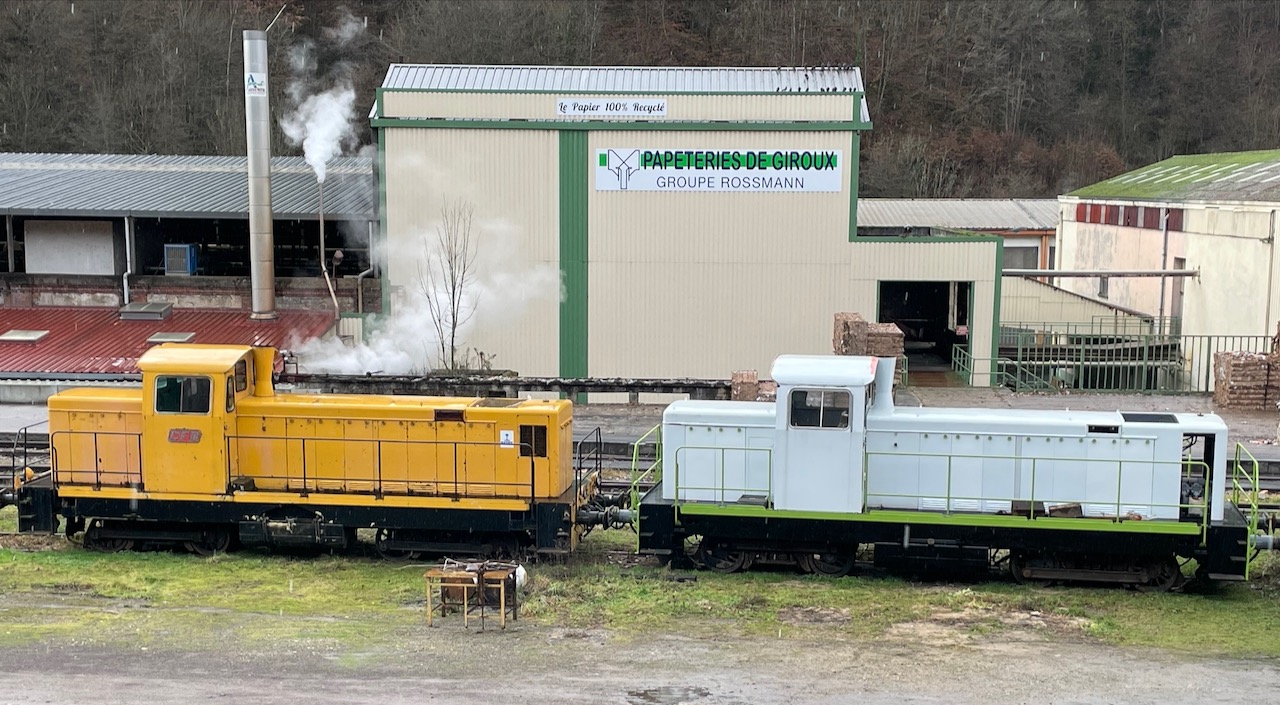
Paper traffic between Courpière and Giroux returning to rail
Paper traffic between Papeteries de Giroux and the CELTA plant at Courpière in Puy-de-Dôme is expected to return to rail by the end of the year. As reported in April News traffic ceased over the 11km section in June 2022 due to the poor condition of the track which failed to meet EPSF (L'Établissement public de sécurité ferroviaire) standards. At that time Syndicat Ferroviaire du Livradois-Forez (SFLF), owner of the 149km route between Pont-de-Dore and Darsac, did not have the funding to undertake repairs. Following cessation of traffic, the operator Combrail has gone into liquidation.
Since closure 2,000 truck journeys have been made between the two plants along the winding D906, carrying 38,000 tonnes of paper and cardboard.
SNLF has now obtained a €400,000 local investment support grant (DSIL) from the State, to which it will add €100,000 from its own funds. This will enable work to be undertaken to replace sleepers and ballast and improve drainage. Returning this section of track to a compliant standard also reopens opportunities for timber and other freight traffic to use the SNLF network. The re-construction work has been contracted to ETF (a Eurovia subsidiary) starting in June, and is expected to last for three months. Freight services should be running again by the end of the year.
With Combrail no longer in existence a new operator is expected to be appointed shortly. New rolling stock will be required as the wagons previously used were in poor condition and have been scrapped. We understand that Combrail’s two Pedalos, BB 71015 and BB 71018 seen above in the yard at Giroux in January 2023, have been sold to Chemin de Fer Touristique de la Vendée. Photo: Roger Allen
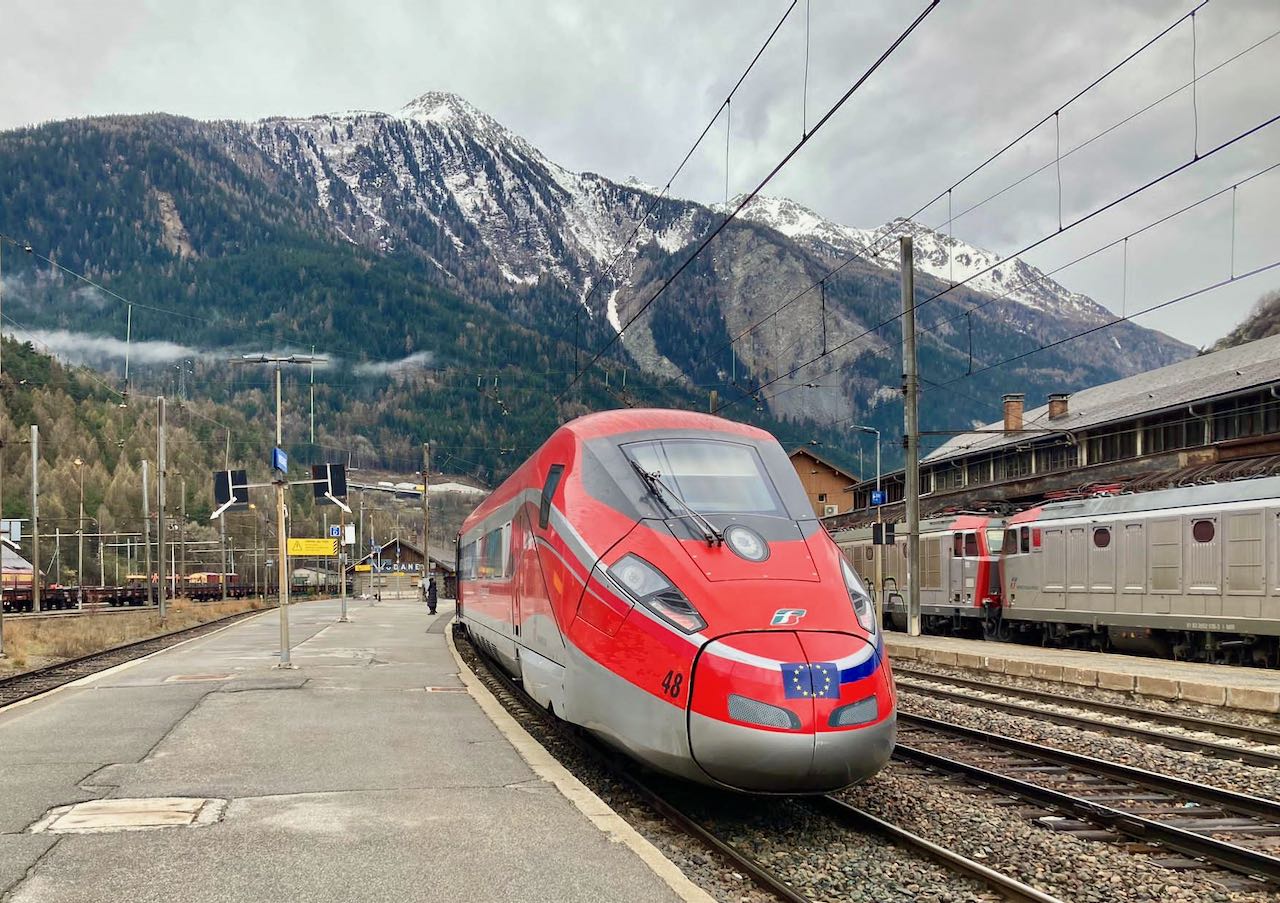
Uncertainty over French section of Lyon – Turin High Speed Line
The new railway is being constructed in three sections. The central 70km cross-border portion including the 57.5km Mont D'Ambin base tunnel is being built by Tunnel Euralpin Lyon Turin (TELT SAS), while the approach lines are the responsibility of the respective national infrastructure managers SNCF Réseau and RFI. The new approach sections are needed to maintain gradients of no more than 1 in 80 to enable freight to travel at a constant 100 km/h, have wide curves to allow passenger trains to run at 220 km/h, and to carry wider-profile traffic than the existing lines.
While the recommendation has been well-received by local environmentalists who have always argued that the line is unnecessary, the Région and elected representatives view the position as unacceptable. They argue that delaying the French section will not diminish the high volume of HGV road traffic and the route will be unable to carry large-profile containers throughout. Passenger journey times will only improve marginally if trains still have to be routed through Chambery and the objective of reducing CO2 emissions from air and road travel will not be met. With the line being built under International Treaty, it has been suggested that Italy could be entitled to compensation if there is a significant delay in building the French approach and thus the benefits of the high-speed route are not achieved.
Above. Trenitalia ETR1000 Frecciarossa set No 48 waits time at Modane on 12th April with Train 9292 the 06.25 Milan – Paris. Arrival at Gare de Lyon was on time at 13.22. These services are expected to continue using the existing high level route through Modane for the next ten years. Photo: Ben Pattison
France at third place in high-speed ranking
Emphasising how small changes can affect the ranking, the survey’s author Jeremy Hartill points out that whereas JR East’s fastest scheduled runs are unchanged from four years ago, France and Spain have slowed their fastest trains slightly and thus dropped down the ranking. Spain is now in sixth place.
The survey also covers the next-generation rolling stock fleets under development, including TGV-M currently on trial at Velim test circuit in the Czech Republic. Murray Hughes, author of Rail 300: The World High Speed Train Race, comments: “Maximum speed for TGV-M in commercial service will be 320 km/h, identical to earlier builds of TGV, so little if any change can be expected in the French ranking. On the other hand, the trains are expected to deliver important savings in operating costs for SNCF”.
For the record, the world’s fastest trains are the two non-stop Beijing – Nanjing evening services which cover the 1,021km between the two cities at an average speed of 317.7 km/h. This schedule is now 50 km/h faster than the next best in any other country, and clearly demonstrates how far ahead China has moved in terms of high-speed rail. Also worth mentioning is the UK’s position in 14th place, behind Russia at 13th. Our thanks to RGI for permission to quote from the survey. Further information can be found at: www.railwaygazette.com

Villeneuve Technicentre modernisation
Introduction of the NG fleet has necessitated replanning of the centre’s maintenance tracks to match the layout of the trains’ onboard equipment, with some new installations required and existing machinery upgraded, plus expansion of the site to 55 Ha for storage sidings to hold 162 trains. Four new entry/exit lines will give easier access from both RER Lines, so that trains entering or finishing service will be less liable to disrupt the timetable. Strengthening of the electric power supply will be required, and an automated depot control system will smooth the path of trains through the various work stages. Amongst strict environmental controls in force, train-washing equipment will recover and reuse 75 per cent of grey water.
A further €95 million is being provided by the Île-de-France région and the State, towards the total project cost of €685 million. In accordance with the aims of Responsabilité Sociétale des Entreprises, there will be a strong bias towards training and employment of local people. Photo: © SNCF
Paris summer of disruption
Major works are under way on several RER and Transilien lines in suburban Paris in an unprecedented programme of upgrading and modernisation taking place within a comparatively short time-frame. Over the summer months, when passenger numbers are much reduced, several lines will close for engineering works from about 22.00 and at weekends.
RER Lines B and C will be severed at Massy-Verrières for two periods from 17th July whilst the Gallardon and Chartres underbridges are replaced. Renewal of these complex crossings of roads and LGV has been in progress since 2020; now one of the world's biggest cranes has been erected on-site to remove the old structures and position the new, weighing 1,090 and 1,670 tonnes respectively. Other works will take place at various points on Line B from June to September, and Bagneux station will be closed, for platform lengthening and signal alterations in preparation for the introduction of MI 20 trains.

On the northern section, turnback sidings are being laid at several locations to help operations recover during periods of disruption.
Elsewhere in Île-de-France, works are being carried out under the regeneration project to overcome years of under-investment. Some projects are being tackled this year, or else deferred, to leave next summer clear for the huge influx of passengers expected during the year's Olympic Games and Paralympics.
On the metro, Line 4 continues to suffer interruptions as automation is rolled out, while construction of extensions to Lines 11 and Line 14 also brings temporary closures.
On the metro, Line 4 continues to suffer interruptions as automation is rolled out, while construction of extensions to Lines 11 and Line 14 also brings temporary closures.
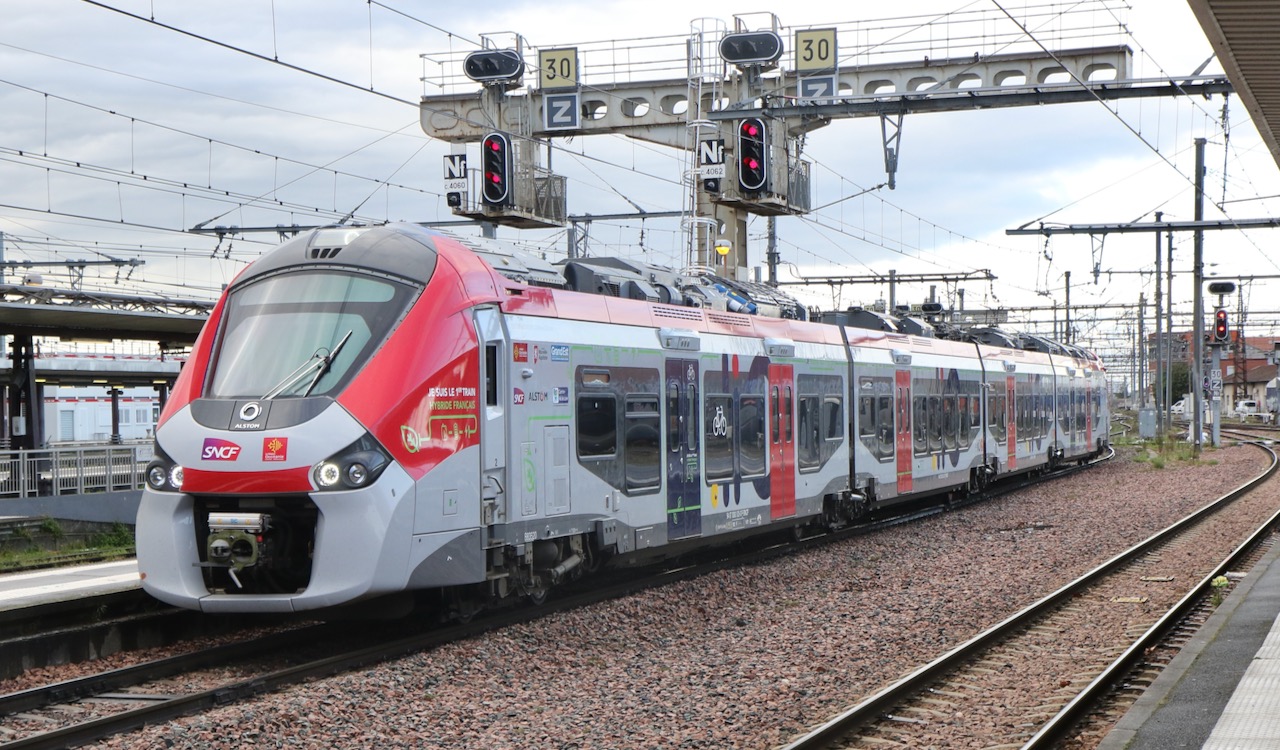
Hybrid Dual-mode Régiolis on test
The batteries can be charged from overhead catenary, the remaining diesel engines and by recovering energy created when braking. Based on typical Régiolis operating patterns braking energy can provide up to 30% of traction energy. Taking account of heating and lighting the use of braking will provide about 20% of the energy requirement. The batteries can also be used to provide supplementary power when operating under low voltage catenary (under catenary 1.5 kV). Following further tests B 83519/20 is expected to enter commercial service later this year.
Above and opposite, B83519/20 at Toulouse on 2nd April upon
its return from Rodez. Surprisingly it was operated by Europorte rather than SNCF. Photos: Georges Turpin

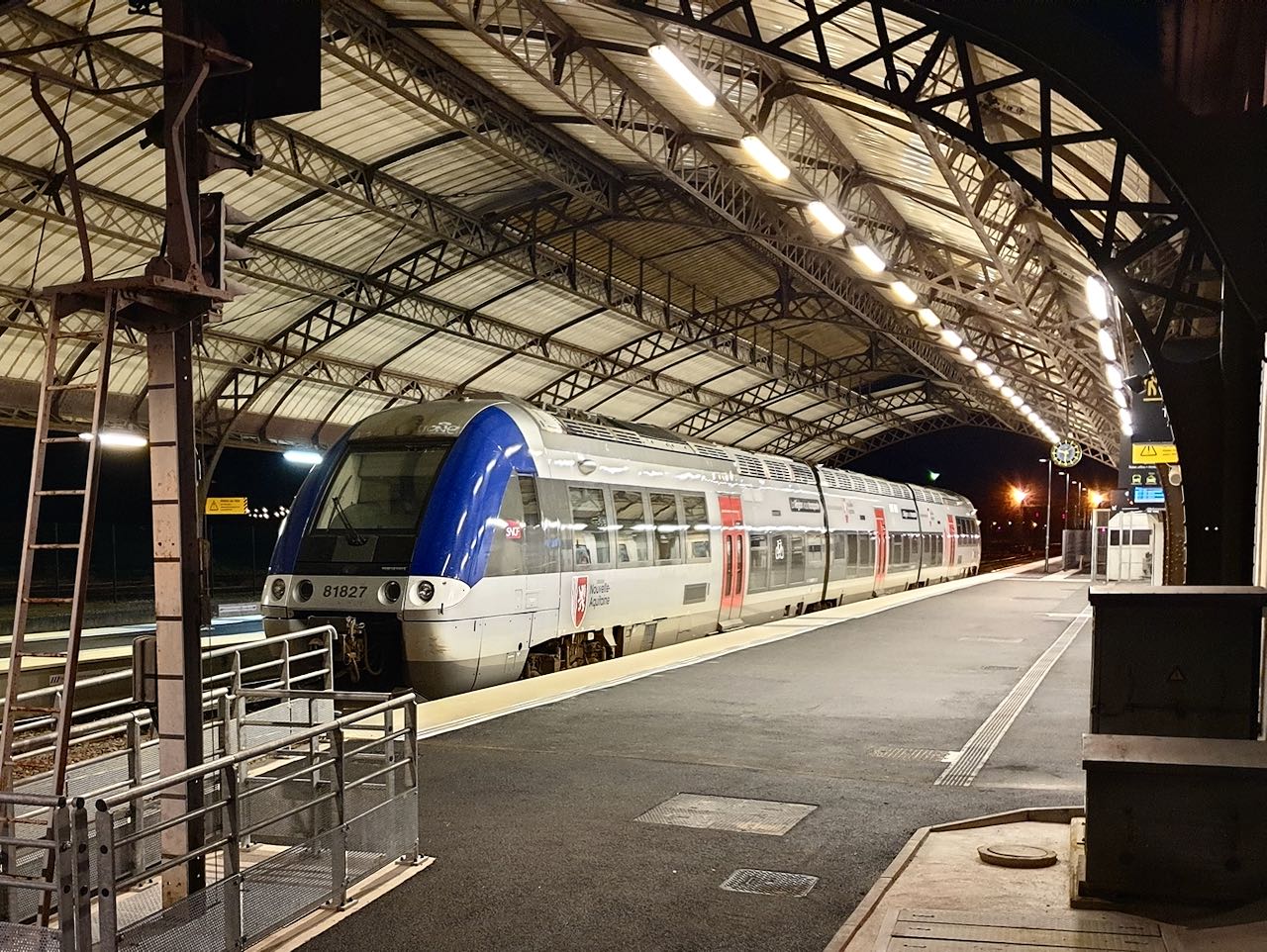
AGC bimode B 81827 in repose at Mont-de-Marsan on 5th April after arrival as Train 866039 19.45 from Bordeaux. The accessibility works mentioned in December’s News are complete and this terminus now has level access to trains at all three platforms. In the last timetable change the number of daily departures increased to 12, though the inconvenient three-hour maintenance gap between 07.41 and 10.46 is unaltered. This fine station lies on the former Morcenx – Tarbes – (Bagnères-de-Bigorre) route, closed beyond Mont-de-Marsan in 1970. It was once junction with four other lines, for which a further now-derelict platform lay outside the marquise. The station retains semaphore signalling controlled from a lever frame on the platform. Photo: John Bamforth
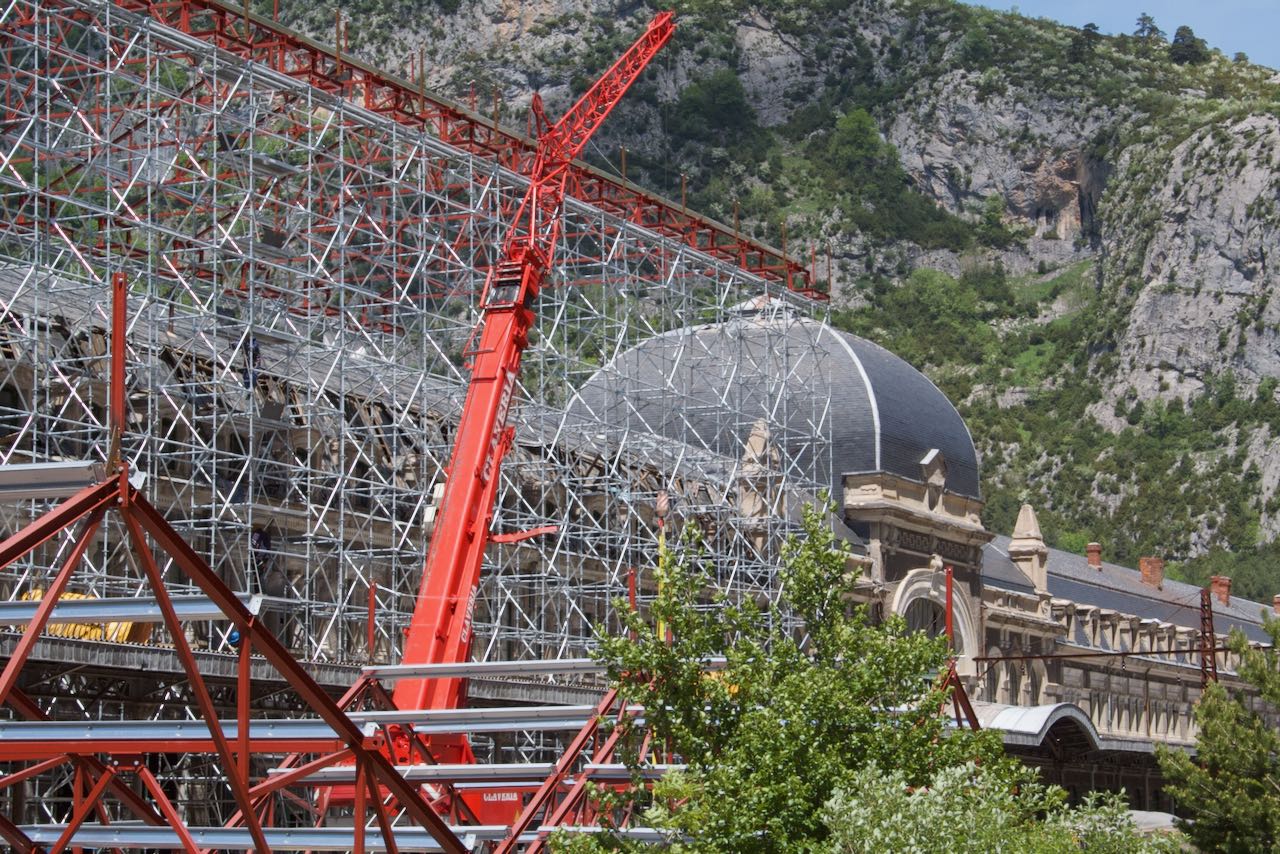
Canfranc revived as five-star hotel
Owned since 2013 by the Aragón regional government, the building is leased to the Barceló hotel group which has completed its transformation into a luxury hotel with 104 bedrooms. Many of the building’s fine architectural features and elaborate interiors have been retained; one of the restaurants is located in coaches restored to early 20th Century Wagons-Lits style. Total cost of the project is €27 million, of which €12 million was contributed by Aragón for the new station opened in 2021. This relocated the passenger station from the front of the building to the rear, utilising one of the freight transhipment buildings.


In the recent call for European funds under the Connecting Europe Facility, an application was made for 50 per cent funding of preparatory works on the Pau – Canfranc – Zaragoza international link costing €18.3 million, sponsored by Spanish infrastructure authority ADIF and the regional governments of Aragón and Nouvelle-Aquitaine. Works on the Spanish side are underway (see February News), but as yet only studies have been funded for reconstruction on the French side. Nevertheless, during a visit to Canfranc on 15th March, President of Nouvelle-Aquitaine région Alain Rousset suggested that the Bedous – Canfranc section, closed since 1970, might reopen in 2028. Photos, top and lower left: John Eden. Lower right Barcelo

Major investment for Chemins de Fer de Provence
The Sud Region and local municipalities have agreed to invest €104 million in the "Ligne des Pins" over the period 2023 - 2026. €56 million will be spent on eight new trains that will replace rolling stock currently used on local services between Nice and Plan-du-Var. The remainder will be spent on infrastructure works, the majority on a new maintenance depot at Nice.
The line remains closed between St-André-les-Alpes and Digne-les-Bains while the longstanding work to repair the tunnel de Moriez continues.

Erwema becomes Streem
Erwema, the former SNCF wagon leasing company and the largest in Europe, is changing its name to Streem. Sold off to Caisse de dépôt et de placement du Québec (CDPQ) and Deutsche Bank in 2021, the change of name signals a plan to double in size by 2030.
Occitanie rail tourism boost
In the latest move to expand use of Occitanie’s TER trains, 18th April saw launch of Occitanie Rail Tour, an initiative to boost rail-based tourism. A €10 go-anywhere day ticket and a new journey-planning app will encourage visitors to leave their cars and sample the scenic delights of the région’s 19 TER routes. The app will also offer booking for local attractions and activities, as well as for overnight accommodation. The initiative is supported by SNCF Connect and Guides Michelin, which is publishing a new guide Le tour de l’Occitanie en train.
As well as encouraging sustainable tourism, Occitanie hopes to prolong the 2023 summer season by capitalising on the influx of tourists expected in Toulouse for the Rugby World Cup during September and October. The move will give further impetus to development of a National Public Transport Ticket, plans for which were announced in February.
Ouigo reaches Perpignan
From the 27th March SNCF introduced a new low-cost Ouigo daily return service from Paris to Perpignan. It is now ten years since it was first launched and Ouigo has been re-branded Ouigo Grande Vitesse .
The new service departs Paris Gare de Lyon at 08.23. Running non-stop to Valence, it then calls at Nîmes, Montpellier, Sète, Agde, Béziers, and Narbonne, arriving at Perpignan at 13.24. The return journey departs from Perpignan at 15.04 calling at the same stops and arriving at Paris at 20.22. Tickets are from €19 single.
Toulouse T2 shut for works
Toulouse’s T2 tram link to Blagnac airport is to close from 5th June for three years so that construction of metro Line C can proceed unhindered. To cope with airport passengers, more trams will run on T1 at peak times and new bus route 31 will provide connections to the airport from Pasteur-mairie de Blagnac and Guyenne-Berry stops; in addition, the airport to city-centre shuttle will be augmented at busy times.
Metro station construction work at Blagnac should be completed by the end of 2026, whilst Line C itself is scheduled to open in 2028.
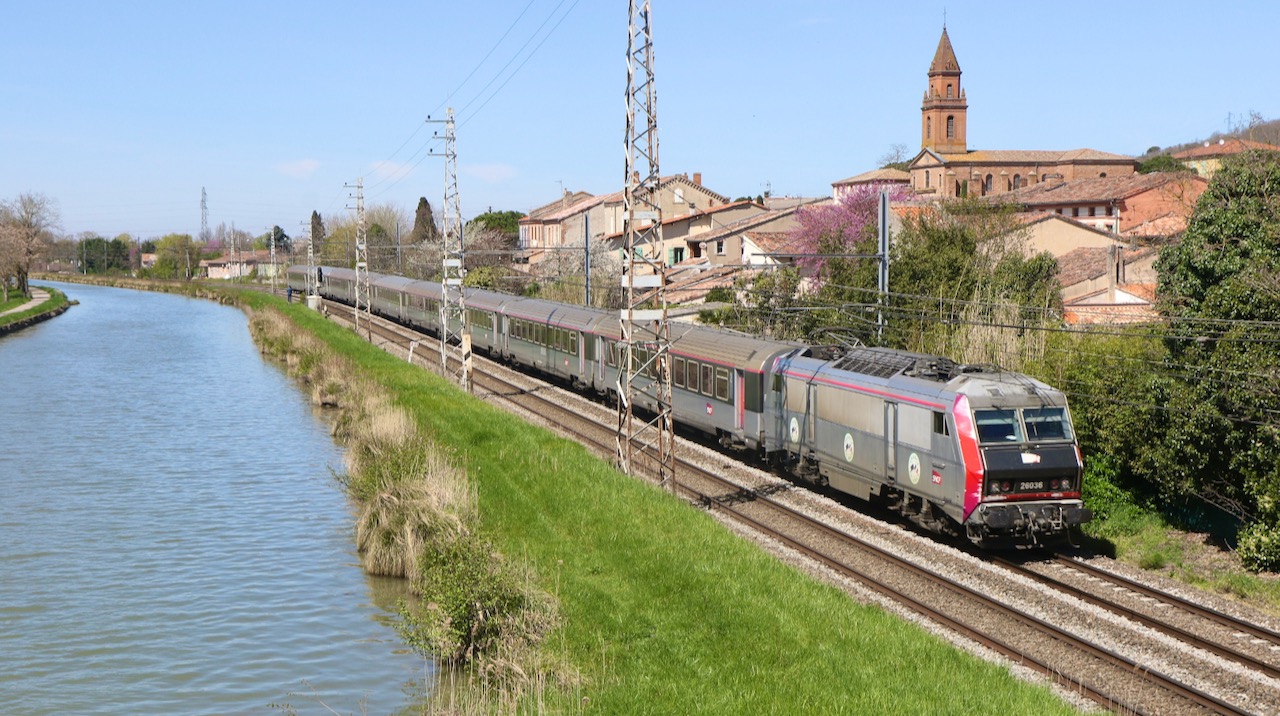
Concern over the future of Bordeaux – Toulouse – Marseille Intercités
In its annual report to the Prime Minister, the Conseil d'Orientation des Infrastructures (COI), a committee of experts and cross-party politicians who advise the government on future rail and road investment, expressed grave concern over the future of the Bordeaux -- Toulouse -- Marseille Intercités service. Over three million passengers a year use the trains, on which the average age of the rolling stock is 44 years and some individual Corail coaches are approaching 50 years old. Locomotives are a mix of BB 7200 introduced over 40 years ago and a handful of BB 26000s built in the early-1990s and cascaded from Paris – Cherbourg services.
The view of the COI is that the current rolling stock will be life-expired by 2027 and the service will need to be reduced or withdrawn if new rolling stock is not available. On the other two locomotive-hauled TET (Trains d'Equilibre du Territoire) services (Paris – Clermont-Ferrand and Paris – Orléans – Limoges – Toulouse POLT), new CAF-built rolling stock will be introduced next year. It had been assumed that trains for Bordeaux – Marseille would be included in the CAF order, and single-deck TGVs have also been proposed for the route.
When asked to comment, SNCF Voyageurs’ response was that TET services are operated on behalf of the State and that future investment is the government’s responsibility.
The view of the COI is that the current rolling stock will be life-expired by 2027 and the service will need to be reduced or withdrawn if new rolling stock is not available. On the other two locomotive-hauled TET (Trains d'Equilibre du Territoire) services (Paris – Clermont-Ferrand and Paris – Orléans – Limoges – Toulouse POLT), new CAF-built rolling stock will be introduced next year. It had been assumed that trains for Bordeaux – Marseille would be included in the CAF order, and single-deck TGVs have also been proposed for the route.
When asked to comment, SNCF Voyageurs’ response was that TET services are operated on behalf of the State and that future investment is the government’s responsibility.
Above. On 5th April BB 26036 runs beside the canal at Pompignan with Train 4661 the 12.28 Bordeaux-Saint-Jean – Marseille-Saint-Charles. Photo: Georges Turpin
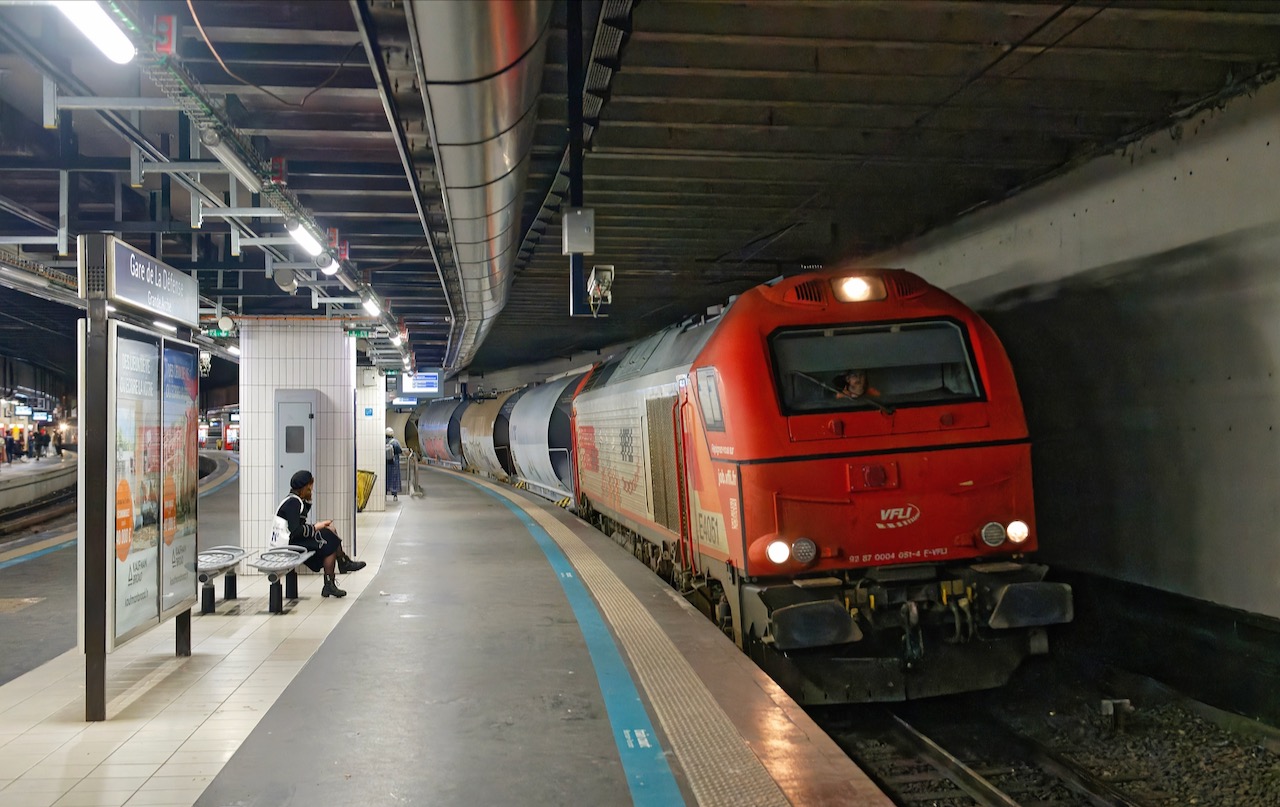
After an absence of many years freight returned to La Défense Grande Arche on 24th March as Captrain E4051 passes through with a train of wood pellets from Chartres to Nanterre for power generation. This is expected to become a weekly working in 2024. Photo: Erwan Quintin.

With the recent social conflict and industrial action at oil refineries and fuel depots, fuel trains have become a rare sight, but on 23rd March E 37516 was captured passing the Canal des Deux Mers at Pompignan with Europorte train 418512 Saint-Jory -- Bassens. Entering service in 2008 for CBRail, subsequently taken over by Akiem, E37516 has been leased by Europorte since 2011. Photo Georges Turpin
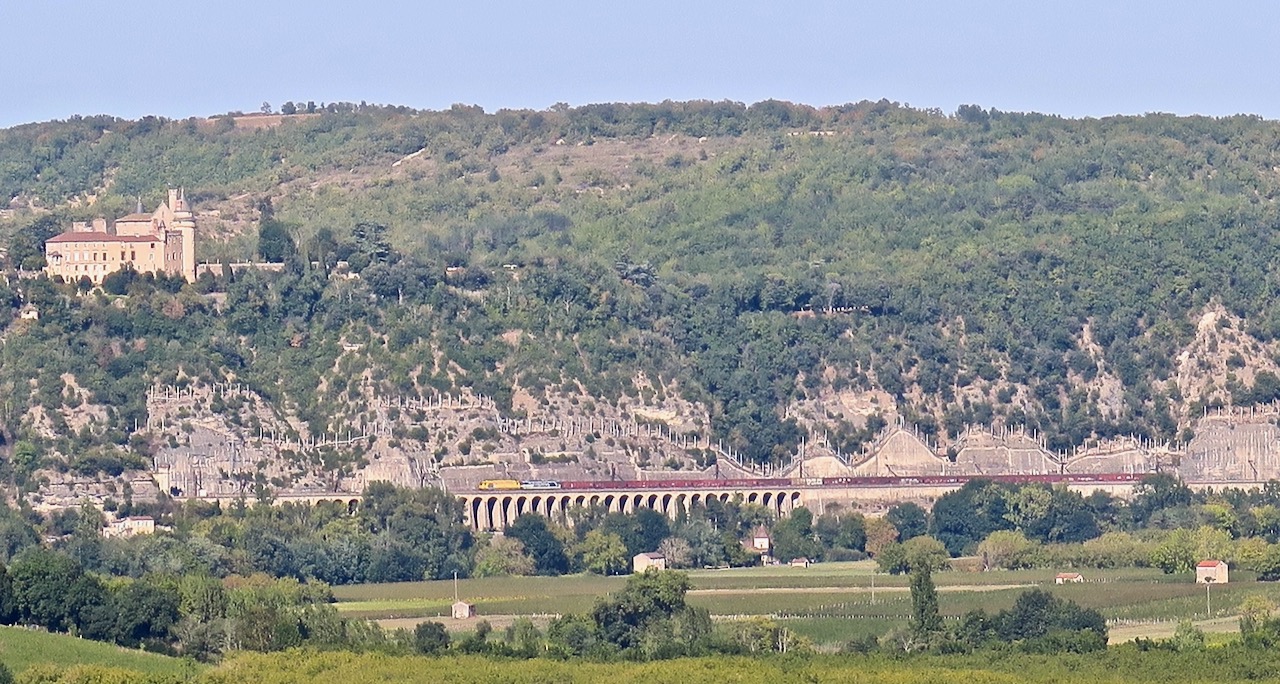
Turning back the clock
Traffic was always light on this line. Immediately after the First World War traffic had fallen to two return services a day, increasing to three in the 1930s. With the introduction of autorails in the 1950s, services reached their heyday with three Agen – Cahors and two Monsempron-Libos – Cahors returns each day. Passenger services were withdrawn in September 1971 and freight a few years later.


Below (left): On the 5th September 1971, a few days before closure, a Class X 5800 and trailer cross the approach to Pont de Luzech with a Cahors – Monsempron-Libos – Agen service. Right: A Class X 3600 emerges from the tunnel with a service in the opposite direction. Pont de Luzech station was a late addition to the line, only opening with the introduction of autorails in the 1950s. Photos: Christian Hospital


Additions to FRS Photographic Archive during March & April 2023
To Photographic section
Additions to Folder 1
PS: Any additions to Folders 4, 7 & 11 (originating from Wikipedia & other sources) have COPYRIGHT RESTRICTIONS and are intended for personal enjoyment by members only
Additions to Folder 1
- A new gallery of some 700 postcards depicting French railway stations, donated by Michael Oakley
- A selection of some 60 photographs taken at the St Mande Model Railway Exhibition by Jacques Pore in January 2023
- A collection of some 825 colour photographs by Denis Lewis, spanning the period 1982 though to 2002, donated by the Friends of the Railway Studies
PS: Any additions to Folders 4, 7 & 11 (originating from Wikipedia & other sources) have COPYRIGHT RESTRICTIONS and are intended for personal enjoyment by members only
Additions to the FRS public folder during February 2023
- Photographic index for the Michael Oakley gallery


© Peter Lovell & Chris Bushell. The French Railways Society 2023. With thanks to Georges Turpin, Christophe Masse, Christian Hospital, Roger Allen, Erwan Quintin, John Bamforth Ben Pattison and John Eden.
